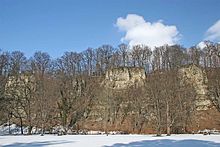Peliny
The Peliny nature reserve is located in Okres Ústí nad Orlicí , Czech Republic . The reserve, declared in 1948, is 3.31 hectares and is located in the cadastral area of the city of Choceň . The name Peliny comes from the Pelín mill that stood here in the Middle Ages. There was once a fortress called Vranov or Koutníkov above the rock in Peliny. However, almost no remains of her have survived.
Protection purpose
The purpose of protection is ravine forests and conspicuous plan cliffs above the Silent Adler river near Choceň, a five-minute walk from the town center. With the exception of the rocky peaks, the whole area is forested. It is a regionally important botanical and zoological site. It is located on the main migration route for warmth-loving flora and fauna between Moravia and the Czech Republic. The tops of the rocks were never forested after the glacial period , so some relics have been preserved here. Some heat-loving plant species are isolated here.
geology
In the reserve there are around 21 different rock faces and rock towers that can reach heights of up to 35 meters. Wooded gorges lie between the individual rocks. The rocks are subject to erosion and crumble. Thanks to the uneven stratification, individual rock formations, many small crevices and caves were created here. The most famous is the so-called horse hole (Koňská díra), with which local legends are associated. The rocks consist of Planer sediments from the Cretaceous period .
Flora and fauna
The steep walls are covered with ravine forests of a primeval forest-like character, with an almost natural composition of the tree step. It is the warmth-loving variant of the ravine forest ( Tilio-Aceretum ). Sessile oak and hornbeam forests ( Melampyro nemorosi-Carpinetum ) can be found in higher elevations, and in areas free of lime with transition to acidic oak forests. In the deeper part of the river there is a weakly developed alluvial forest . Rock vegetation has developed on the crags.
The flora of the local forests has a rich spring aspect. You can find liverwort , wood anemone , yellow anemone , forest violet , hill violet , hollow lark's spur , peach-leaved bellflower , Turkish league and many other species. The occurrence of some isolated species is interesting. One example is the golden yellow stone herb , which is visible from far on the rocks with its yellow flowers in May. However, it is debatable whether this species is endemic here. This is undisputed in the case of bleaching sheep fescue . The common pimpernut occurs in Moravia, to the west of here it has certainly immigrated. The swallowwort and the common cotoneaster also grow relatively isolated here . The medicinal root population may be related to the former Vranov Fortress. A conspicuous grass is the onion bluegrass , which is not found here in isolation. Dozens of other plant species grow in Peliny.
Some rare species of molluscs live here, such as the whorl snail . Birds include the great spotted woodpecker , the great tit , the blue tit , the nuthatch and the treecreeper , while the tawny owl and the eagle owl are among the owls .
Web links
- orlickehory.webz.cz
- Photo gallery
- Lucie Juřičková, Michal Horsák and Magda Hrabáková: Měkkýši PR Peliny u Chocně. Malacologica Bohemoslovaca (2006), 5: 10–13 (pdf; 325 kB)
Coordinates: 50 ° 0 ′ 8 ″ N , 16 ° 14 ′ 0 ″ E
